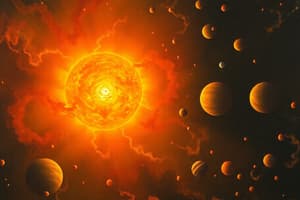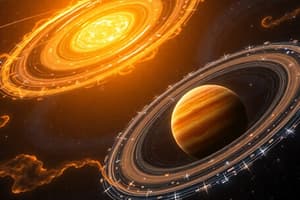Podcast
Questions and Answers
Which type of planets are Jupiter, Saturn, Uranus, and Neptune known as?
Which type of planets are Jupiter, Saturn, Uranus, and Neptune known as?
What distinguished feature do Jupiter and Saturn have compared to Uranus and Neptune?
What distinguished feature do Jupiter and Saturn have compared to Uranus and Neptune?
Which region marks the extreme edges of our sun's gravitational influence?
Which region marks the extreme edges of our sun's gravitational influence?
What is the main factor that allowed Jovian planets to retain a significant amount of hydrogen and helium content?
What is the main factor that allowed Jovian planets to retain a significant amount of hydrogen and helium content?
How did the inner terrestrial planets, Mercury, Venus, Earth, and Mars, form according to the text?
How did the inner terrestrial planets, Mercury, Venus, Earth, and Mars, form according to the text?
Why were the inner planets the last to form in the solar system?
Why were the inner planets the last to form in the solar system?
Why didn't the inner planets grow as massive as the outer planets?
Why didn't the inner planets grow as massive as the outer planets?
What could explain Mars' loss of its outer layer?
What could explain Mars' loss of its outer layer?
Why does the asteroid belt serve as a testament to the violent birth of the inner planets?
Why does the asteroid belt serve as a testament to the violent birth of the inner planets?
What remains a source of mystery and discovery in our solar system?
What remains a source of mystery and discovery in our solar system?
Flashcards are hidden until you start studying
Study Notes
The Solar System: Planets and Their Origins
As our sun's celestial dance through the Milky Way galaxy unfolds, it guides eight planets and a cast of smaller worlds. From the closest, scorching Mercury to the icy, outermost realms of Neptune, each planet tells a tale of the solar system's birth and evolution.
Terrestrial Planets
The inner four planets—Mercury, Venus, Earth, and Mars—are rocky and dense, with solid surfaces and the capacity for life. They formed from the remnants of a dense cloud of interstellar gas and dust, barely surviving the intense heat of the young sun's core.
Jovian Planets
The next four planets, Jupiter, Saturn, Uranus, and Neptune, are gaseous giants. Their mass and distance from the sun allowed them to retain a significant amount of their hydrogen and helium content, forming a deep atmosphere. Jupiter and Saturn are further distinguished by their ring systems, while Uranus and Neptune boast a collection of moons.
Dwarf Planets and Other Celestial Bodies
Beyond the eight planets lie smaller worlds like Pluto, which was reclassified in 2006 as a dwarf planet. However, it's an intriguing miniature solar system in itself, with its five moons. The Kuiper Belt and Oort Cloud—both sparsely occupied rings of icy bodies—mark the extreme edges of our sun's gravitational influence.
The Formation of Planets
As the solar system coalesced, tiny dust particles in the disk around the sun collided and stuck together. Over millions of years, these collisions and accretions formed larger objects, eventually growing into the planets we know today. The inner planets, rich in rocks and metals, were the last to form, due to their proximity to the sun.
A Tale of Collisions and Debris
The solar system's inner planets didn't grow as massive as the outer planets because the proportion of rocks and metals available in the universe decreased with distance from the sun. Mars, for example, may have experienced a high-speed collision with a planet-sized object, which could explain the loss of its outer layer.
The asteroid belt, a region of space rocks left over from the formation of the inner planets, serves as a testament to their violent birth.
The Continuing Enigma
The solar system, a fascinating and vast neighborhood, remains a source of mystery and discovery. Recent missions have revealed much about our cosmic surroundings, but there's still much to learn about our planetary siblings and their origins.
Studying That Suits You
Use AI to generate personalized quizzes and flashcards to suit your learning preferences.




